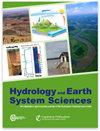Towards reducing the high cost of parameter sensitivity analysis in hydrologic modeling: a regional parameter sensitivity analysis approach
IF 5.8
1区 地球科学
Q1 GEOSCIENCES, MULTIDISCIPLINARY
引用次数: 0
Abstract
Abstract. Land surface models have many parameters that have a spatially variable impact on model outputs. In applying these models, sensitivity analysis (SA) is sometimes performed as an initial step to select calibration parameters. As these models are applied to large domains, performing sensitivity analysis across the domain is computationally prohibitive. Here, using a Variable Infiltration Capacity model (VIC) deployment to a large domain as an example, we show that watershed classification based on climatic attributes and vegetation land cover helps to identify the spatial pattern of parameter sensitivity within the domain at a reduced cost. We evaluate the sensitivity of 44 VIC model parameters with regard to streamflow, evapotranspiration and snow water equivalent over 25 basins with a median size of 5078 km2. Basins are clustered based on their climatic and land cover attributes. Performance in transferring parameter sensitivity between basins of the same cluster is evaluated by the F1 score. Results show that two donor basins per cluster are sufficient to correctly identify sensitive parameters in a target basin, with F1 scores ranging between 0.66 (evapotranspiration) and 1 (snow water equivalent). While climatic attributes are sufficient to identify sensitive parameters for streamflow and evapotranspiration, including the vegetation class significantly improves skill in identifying sensitive parameters for the snow water equivalent. This work reveals that there is opportunity to leverage climate and land cover attributes to greatly increase the efficiency of parameter sensitivity analysis and facilitate more rapid deployment of land surface models over large spatial domains.降低水文建模中参数敏感性分析的高成本:一种区域参数敏感性分析方法
摘要陆地表面模型具有许多参数,这些参数对模型输出具有空间可变的影响。在应用这些模型时,有时会将灵敏度分析(SA)作为选择校准参数的初始步骤。由于这些模型应用于大型领域,因此在整个领域进行灵敏度分析在计算上是令人望而却步的。在这里,以可变入渗能力模型(VIC)在大域中的部署为例,我们表明基于气候属性和植被土地覆盖的流域分类有助于以更低的成本识别域内参数敏感性的空间模式。我们评估了44个VIC模型参数对25个流域(中值大小为5078)的流量、蒸散和雪水当量的敏感性 km2。根据其气候和土地覆盖属性对盆地进行聚类。在同一聚类的盆地之间传递参数敏感性的表现通过F1分数来评估。结果表明,每个聚类有两个供体盆地足以正确识别目标盆地中的敏感参数,F1得分在0.66(蒸散量)和1(雪水当量)之间。虽然气候属性足以识别径流和蒸散的敏感参数,但包括植被类别在内,显著提高了识别雪水当量敏感参数的技能。这项工作表明,有机会利用气候和土地覆盖属性,大大提高参数敏感性分析的效率,并促进在大空间域上更快地部署地表模型。
本文章由计算机程序翻译,如有差异,请以英文原文为准。
求助全文
约1分钟内获得全文
求助全文
来源期刊

Hydrology and Earth System Sciences
地学-地球科学综合
CiteScore
10.10
自引率
7.90%
发文量
273
审稿时长
15 months
期刊介绍:
Hydrology and Earth System Sciences (HESS) is a not-for-profit international two-stage open-access journal for the publication of original research in hydrology. HESS encourages and supports fundamental and applied research that advances the understanding of hydrological systems, their role in providing water for ecosystems and society, and the role of the water cycle in the functioning of the Earth system. A multi-disciplinary approach is encouraged that broadens the hydrological perspective and the advancement of hydrological science through integration with other cognate sciences and cross-fertilization across disciplinary boundaries.
 求助内容:
求助内容: 应助结果提醒方式:
应助结果提醒方式:


